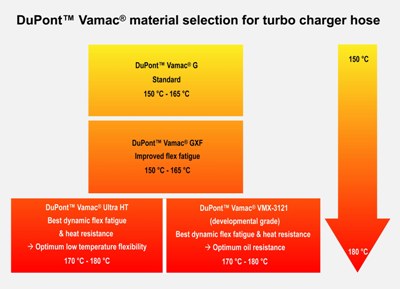DuPont Performance Polymers has announced that DuPont Vamac Ultra HT ethylene acrylic elastomer (AEM) has been unveiled at the DKT 2012 German Rubber Conference, held in Germany.

This new product is resistant to heat from 180°C to a maximum of 200°C and has enhanced mechanical properties. This Vamac Ultra product can be mainly used for air ducts and automotive turbo hoses, in order to fulfill the challenging engine environments.
The AEM grades can be polymerized using the advanced production technology for Vamac, in order to obtain optimized chemical composition and structure. Significant enhancements are made in the polymerized AEM grades, when compared to standard Vamac elastomers.
The company unveiled Vamac Ultra, higher viscosity AEM grades, during 2006. These grades improved AEM performance, processing, and customer value in applications. Therefore, they are being used in the automotive market.
The performance of AEM grades in long-term heat ageing properties has been improved by the new Vamac Ultra HT. A study carried out by DuPont Performance Polymers compared the acrylic rubbers’ ageing property in air at a temperature of 150°C for 5,000 h. It showed that Vamac Ultra HT surpassed in performance, when compared to other ACM, AEM, and HT-ACM polymers that were examined for final mechanical properties like hardness change and absolute elongation in the heat ageing conditions.
Klaus Kammerer, a scientist from DuPont Performance Polymers, is presenting a paper, titled “DuPont Vamac Ultra — Latest AEM Polymers and Developments — Meeting Demands of Modern Engine Technology,”at the International Rubber Conference, which is ongoing from 2 to 5 July, 2012 in Germany.
Vamac Ultra HT provides improved mechanical properties at room and high temperature. These properties include hot tear strength, low temperature flexibility, hot elongation, greater acid resistance in blow-by gas, higher resistance to flex fatigue, and exhaust gas recirculation environments.
Vamac Ultra HT helps automotive OEMs to meet present Euro 5 and future Euro 6 emission regulations.